Performance
Profitability and return – exceptional financial performance
Divisional performance
The following divisional combined ratios are after removing the exchange differences on the translation of non-monetary assets and liabilities.
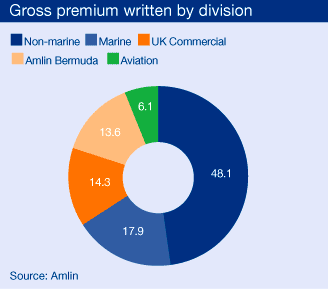
Gross premium written by geography
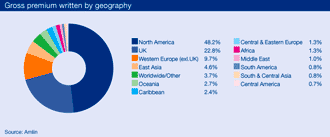
Click here for full sized image
Non-marine
Non-marine
Key statistics for 2007
- Gross premium written of £500.6 million
- Net earned premium of £426.2 million
- Combined ratio of 59%
- Number of senior underwriters*: 14
- Senior underwriter turnover+: 0%

Non-marine underwrites a diverse portfolio of property and casualty insurance and reinsurance classes although the focus remains short tail. It is a major lead reinsurer of property catastrophe exposures. This is complemented by more attritional lines including casualty, auto and medical expenses.
The division leads 49% of the business it writes. 63% of the business emanates from the US, where it is written on an insurance (typically surplus lines) and reinsurance basis.
The division’s main competitors are other syndicates in the Lloyd’s market, major European reinsurers, US property and casualty companies and the Bermudian market.


Click here for full sized image
Non-marine is the Group’s largest division accounting for £500.6 million of gross premium written in 2007 (2006: £554.6 million). The business written is a mix of classes which are exposed to catastrophic loss (for example catastrophe reinsurance), large claim events (for example aviation reinsurance) and attritional claims (for example auto and casualty). In 2007 the catastrophe reinsurance and property classes wrote £371.4 million of premium, representing 74% of divisional gross premium written.
Geographically the division’s largest market is the United States, which represented 63% of business written in 2007. Diversity is significant, however. In the United States our property catastrophe underwriting is centred on regional insurers and regional exposures are monitored closely. Internationally, our insurance and reinsurance programmes include windstorm cover in Europe, earthquake and windstorm exposure for Japan and earthquake protection in Australia and New Zealand.
The average rate of renewal for the division was a reduction of 5.4% (2006: increase of 11.5%). US catastrophe reinsurance pricing remained relatively strong with rates increasing by 1.5%. However this should be viewed in the context of the prior year when rates increased by 28.3% as a response to the hurricanes of 2005.
International catastrophe pricing was more disappointing with rates falling by 5.0% as more reinsurers looked to diversify their portfolios. However, pricing in more capacity constrained zones, such as Europe and the Caribbean remained adequate.
The renewal retention rate was 80% (2006: 80%).
A combined ratio of 60% is another excellent result (2006: 66%). The key driver was the low level of catastrophe losses in the year, aided by good claims development on prior years, resulting in a claims ratio of 29%. Run off profits from reserves of £50.0 million were made (2006: £21.9 million).
Marine
Marine
Key statistics for 2007
- Gross premium written of £187.2 million
- Net earned premium of £157.1 million
- Combined ratio of 81%
- Number of senior underwriters*: 9
- Senior underwriter turnover+: 11%

Marine writes a mixture of volatile classes, like energy and war, and more attritional classes, such as hull and cargo. 41% of business is written on a lead basis. Business is worldwide, reflecting the nature of the risk. However, yacht and bloodstock have a greater UK focus.
The global marine market consists of Lloyd's, European reinsurers and specialist markets. In terms of specialist markets, the Norwegian marine (Cefor) hull market has competed strongly in this sector over the last decade and now challenges Japan as the second world market to London for this business.
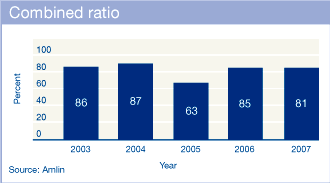

Click here for full sized image
The Marine division contributed £187.2 million to gross premium written in 2007 (2006: £210.9 million). The division writes a combination of volatile classes including energy, specie and war, but also attritional classes such as hull, cargo and yacht. Business written is worldwide, however the bloodstock and yacht accounts have a UK bias.
Rating conditions remained relatively good in the year, with an average divisional renewal rate reduction of 4.1% (2006: 4.5% increase). The average rate reduction within the energy account was 7.5% and war continued to experience more challenging pricing conditions, with limited loss activity experienced in the year and increased competition as a result. Attritional classes, such as hull, cargo and yacht experienced more modest rate reductions. The renewal retention rate was 76% (2006: 79%).
The Marine division’s combined ratio increased modestly to 83% (2006: 81%). Reserve release totalled £8.0 million (2006: £19.1 million).
Aviation
Aviation
Key statistics for 2007
- Gross premium written of £63.6 million
- Net earned premium of £47.0 million
- Combined ratio of 68%
- Number of senior underwriters*: 7
- Senior underwriter turnover+: 0%
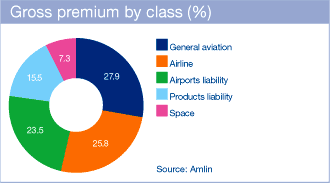
Aviation classes are exposed to large aviation disasters and potentially catastrophic losses. The line size required in this area is large and a comprehensive reinsurance programme is fundamental to writing this business.
The division leads 44% of business written. Business is predominately written in US dollars. In 2007, 44% of premium was sourced from the US, with the UK and Europe contributing a further 39% of business.
The global aviation market consists of the Lloyd’s market, European reinsurer’s and specialist markets around the world. The market includes a number of major participants, such as Global Aerospace and the AIG Group.


Click here for full sized image
The division writes a mixture of classes including airline, general aviation, airport and product liabilities and satellite insurance. The classes are exposed to large loss events and potential catastrophic loss. As such, a comprehensive reinsurance programme is fundamental to writing this business.
The Aviation division accounted for £63.6 million of gross premium written in 2007, down 16% on the prior year (2006: £75.7 million). The largest contribution to written premium was provided by airline (hull and liabilities), general aviation and airport liability which together count for 77% of the portfolio. 33% of business was ceded to reinsurers.
With additional capacity entering the aviation market during the year, intense rating competition has continued to exist and disciplined underwriting has meant our portfolio has reduced as intended. The average divisional renewal rate reduction was 13.0% (2006: 19.0%). The overall renewal retention rate has remained steady at 80% (2006: 81%).
The combined ratio of 70% is a pleasing result (2006: 84%), the consequence of a falling claims ratio to 33%. Run off profits from reserves amounted to £15.9 million (2006: £8.0 million) with little claims development in the year.
UK Commercial
UK Commercial
Key statistics for 2007
- Gross premium written of £149.2 million
- Net earned premium of £130.3 million
- Combined ratio of 85%
- Number of senior underwriters*: 16
- Senior underwriter turnover+: 22%
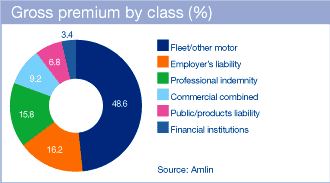
The UK commercial market underwrites UK motor, property and casualty business. The market includes companies such as Royal & Sun Alliance, Norwich Union and Axa.
UK Commercial underwrites mainly UK based clients, with the majority of risks written on a 100% basis. The portfolio consists of well managed motor, liability and property insurance risks. The property book is growing steadily particularly in relation to specialist scheme business.
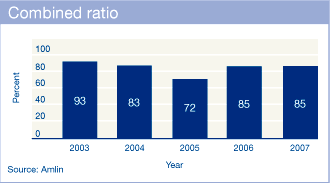

Click here for full sized image
The UK Commercial division writes business principally for UK based clients and the majority of risks are not written in the subscription market but are assumed entirely by the division. The division underwrites a balanced portfolio of motor and liability business, combined with a small property account. Catastrophe risk is reinsured and, inherently, the divisional profile is attritional in nature.
£149.2 million of gross premium was written in the year (2006: £150.0 million). The division has continued to experience rating pressure in all classes and our team has focused its efforts on risk selection and underwriting profitability, together with delivery of high levels of client service to a core client base which has a strong record of continuity with the business.
The average renewal rate reduction was 5.2% (2006: 2.7%). Claims inflation also continues to erodemargins. The relatively low renewal retention rate of 71% (2006: 68%) reflects our disciplined underwriting approach.
Within this challenging market, the combined ratio of 86% is a strong result (2006: 84%). Run off profits from reserves of £22.1 million (2006: £19.8 million) reflect the release of case reserves as claims settle below expectations.
Amlin Bermuda
Amlin Bermuda
Key statistics for 2007
- Gross premium written of £232.8 million
- Net earned premium of £216.2 million
- Combined ratio of 46%
- Number of senior underwriters*: 2
- Senior underwriter turnover+: 0%
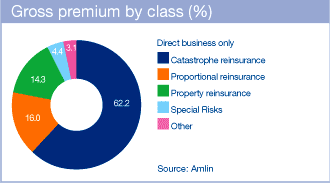
The Bermudian market specialises in large commercial risks and reinsurance. It has grown to be a significant market, particularly for US risks.
Amlin Bermuda began trading in December 2005. It is capitalised in excess of US$1 billion and competes in the specialist reinsurance market.
Amlin Bermuda sources much of its business through global brokers operating in the London subscription market.
The business writes predominantly catastrophe reinsurance and property reinsurance similar to that written in London. 62% of business was generated from the US in 2007.


Click here for full sized image
Amlin Bermuda underwrites reinsurance in most areas of the world, but does not have the ability to write insurance as it does not hold relevant licenses. In order to gain exposure to the diversity offered by some non catastrophe insurance accounts, Amlin Bermuda has written specific class reinsurances plus a 10% quota share reinsurance of Syndicate 2001. During 2007 no third party reinsurance was purchased by Amlin Bermuda.
Amlin Bermuda wrote £232.8 million, or US$465.8 million, of gross premium in the year (2006: £223.5 million, or US$411.2 million). Of this £90.3 million, or US$180.6 million, of premium was attributable to quota share and other reinsurances of Syndicate 2001 (2006: £100.8 million, or US$185.5 million). The average renewal rate was a reduction of 7% and the average renewal retention rate was 76%.
Growth has been constrained as primary carriers have chosen to maintain our share of risk at levels consistent with the previous year, in the face of growing competition for lines. This is more satisfactory than fierce competition on price. Importantly, the quality and diversity of the book is good and we have not compromised standards simply to hit premium income targets.
The combined ratio of 46% is a strong result (2006: 48%). This reflects the low level of catastrophe losses and limited development on claims in the year, resulting in a claims ratio of 34%. Run off profits on reserves amounted to £13.0 million (2006: nil). The expense ratio of 12% is low relative to the London operations due to the high operational gearing of the reinsurance business written in Bermuda and the effect of intra-Group reinsurance.
Investment performance
The contribution to profit for the year from investments increased by 36.4% to £157.0 million (2006: £115.1 million). The return on average cash and investment balances of £2.4 billion was 6.6% (2006: £2.3 billion, 4.8%). The increase in assets under management was due to strong organic cash flows and profitable trading.
The investment environment in 2007 has been volatile as the potential economic cost of defaults from sub-prime borrowers in the United States and the weak US housing market, led to a liquidity crisis in the financial system. The diverse portfolio structure of the Group’s assets helped to weather the storm through 2007. The global equity portfolio produced a return of 10.2% – our managers invested defensively and were not over exposed to the US market.
In August the investment risk appetite was reduced as explained here.
The underlying performance of bond assets was markedly divergent with strong performance from the government portfolios, as investors factored in likely interest rate cuts in the anticipation that central banks would respond proactively to economic slowdown.
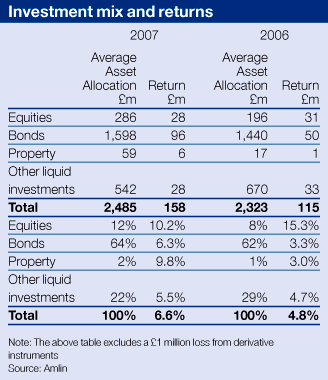
However, credit exposure, either through corporate bonds or structured bond portfolios such as mortgage backed securities, fared badly.
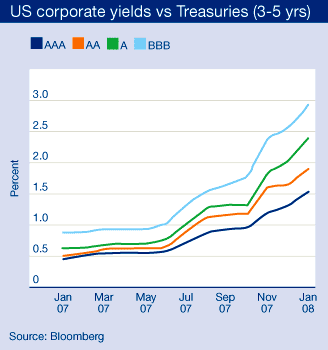
The underperformance of our bond investment managers against their government benchmarks amounted to £19.8 million. This illustrates the impact of credit market dynamics on our portfolio.
Expenses
Total expenses, including underwriting, nonunderwriting and finance costs, decreased to £332.9 million from £345.9 million in the prior year. This decrease is a result of a favourable swing in non monetary foreign exchange adjustments offset by an increase in staff incentive payments.
Business acquisition costs of £196.0 million, representing 18% of gross earned premium, were consistent with the prior year (2006: £195.4 million, 18%). These include an element of the foreign exchange translation of non-monetary assets and liabilities and other foreign exchange movements, which in total increased 2007 expenses by £5.1 million (2006: 0.4 million).
Non-underwriting costs (excluding finance costs) increased by £31.5 million to £49.8 million. Within this, total staff costs increased from £25.0 million to £42.3 million. Staff incentive plans accounted for £31.4 million of these costs (2006: £18.6 million).
Taxation
The effective rate of tax for the period is 20.7% (2006: 21.9%). The reduction is mainly attributable to the fall in the rate of UK corporation tax.
The effective rate is below the UK rate of corporation tax primarily due to Amlin Bermuda. We believe that Amlin Bermuda is exempt from the Controlled Foreign Corporation tax provisions of the UK tax regime. Accordingly, the Group will pay tax to the UK tax authorities only when distributions are made back to its UK holding companies. We have again provided for tax on possible future distribution through deferred tax of 9% of Amlin Bermuda’s profit.
The standard rate of UK corporation tax is due to fall from 30% to 28% from 1 April 2008, which affects the deferred tax provision in two ways. Firstly, an adjustment was required to those elements of the deferred tax provision at 1 January 2007 which were expected to reverse after 31 December 2007. This adjustment generated a credit to the deferred tax charge of £1.7 million. Secondly, temporary differences arising in 2007 will affect the 2007 corporation tax charge at a rate of 30%, but will generate deferred tax at a rate of 28% or 28.5% (the effective corporation tax rate for 2008). This has generated a credit to the tax charge of £5.1 million.
Dividends
The Board proposes a final ordinary dividend of 10.0 pence per share. Taken together with the interim dividend of 5.0 pence per share and the return of capital under the B share scheme approved at the EGM in December 2007 of 22.4 pence per share, this gives total payments to shareholders for 2007 of 37.4 pence per share in issue at the time (equivalent to 34.4 pence per share following the consolidation of December 2007).
